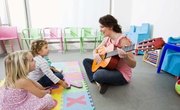Pervasive Developmental Disorders--Not Otherwise Specified (PDD-NOS) refer to a range of disorders widely considered to be on the spectrum of autistic disorders. Children with PDD-NOS bring unique challenges to the classroom that teachers must recognize and mitigate. The Colorado Department of Education reports that these kids are generally bright and often possess above-average intelligence. Difficulties in communication, sensory integration and social interaction are the biggest obstacles standing in the way of a successful education for children with PDD-NOS.
Know the child's Individualized Education Plan (IEP). An IEP describes how children's diagnosis or disability may effect their ability to learn in a typical classroom and what accommodations are necessary to mitigate those issues. Depending on the child's exact physical, mental and emotional needs, he or she will need certain accommodations that are listed in the IEP. According to the Colorado Department of Education, some students with PDD-NOS may require smaller classroom sizes, while others will need to rely on specific strategies to lower anxiety.
Use social stories to aid students in social encounters. Social stories employ developmentally appropriate language a teacher or caregiver can use to explain a concept, social interaction, interpretation of a social event, perspectives or social cues. Because children with PDD-NOS often struggle to understand social cues and appropriate social interactions, these stories explain social behavior and give children a plan of action for particular social situations.
Reduce anxiety in the classroom so children can learn more effectively. Autism Help, a website that offers information on autism spectrum disorders, suggests that teachers can minimize the anxiety children with PDD-NOS frequently battle by maintaining a structured routine and placing an illustrated schedule on the wall so the children will always know what to expect.
Tip
Stay in contact with the child's parents because they may have information or insight that will help you more effectively teach.
Related Articles
References
Tips
- Stay in contact with the child's parents because they may have information or insight that will help you more effectively teach.
Writer Bio
Jennie Dalcour began writing Internet content in 2009. She has worked several years in the telecommunications industry and in sales and marketing. She has spent many years teaching young children and has spent over four years writing curriculum for churches. She is now pursuing a Masters of Arts in clinical psychology at Regent University and has ample experience with special needs children.










